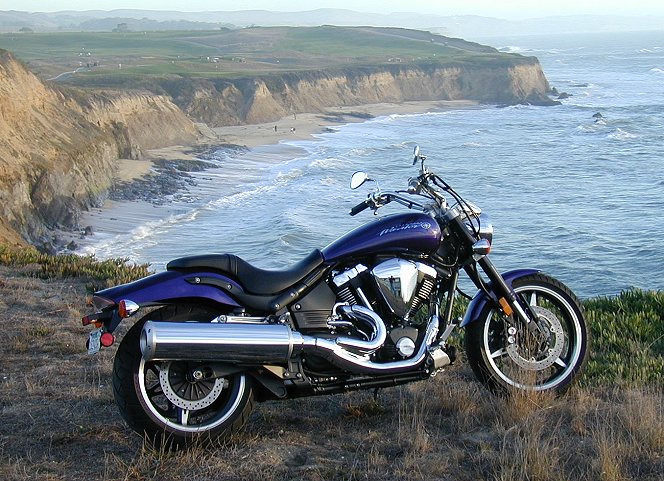
Yamaha likes to be different. The first Japanese manufacturer with a four-stroke motocross bike, and the developer of the “no compromises” R1 — already a legend in the sportbike class after just four years on the market — not surprisingly, took its own path when developing a “power cruiser”.
While Harley “sold out” to liquid cooling and overhead cams, Yamaha deliberately stayed with an air-cooled, pushrod, Road Star-derived engine displacing 1670cc. The first production power cruiser with an air-cooled engine is also the first production power cruiser (probably, the only power cruiser) with an aluminum frame. Yes, Yamaha’s new Road Star Warrior is different.
When Yamaha invited me to a five-star luxury hotel at beautiful Half Moon Bay in central California to ride its newest creation, I had to accept. Arriving a bit rumpled in jeans and a taco-stained shirt (after seven hours of driving), I was somewhat self-conscious entering the lobby of this millionaires’ retreat (valet parking is $25.00 per day, plus tip — get the idea?). Rushing to my room to change my shirt, I arrived at dinner and was immediately put at ease by the Yamaha personnel and the other journalists present. As I started to unwind and eat the French creation placed on the table in front of me (unidentifiable, but delicious), I knew this would be an interesting couple of days. I was right.
The Warrior rides differently, too. The traditional, air-cooled engine comes through with excellent power (more about that below), and easily the most soulful exhaust note in the class (how did you get that past the sound police, Yamaha?). Indeed, the Warrior combines a traditional feel and rumble that is difficult to produce in a liquid-cooled design with near sportbike-levels of grip in the corners.
Although I will inundate you with technical details in a follow-up article (I am dictating this on the seven hour return trip), Yamaha explained its goal of combining traditional cruiser values (which dictated the engine design, for instance) with high levels of actual performance. The aluminum chassis was designed to be lightweight (it is dramatically lighter than the Road Star’s steel frame), but extremely rigid (more rigid than one of Yamaha’s earlier 500 GP bikes, interestingly enough). This rigidity, combined with very sticky rubber (that includes a 200 section tire in the back) allows ridiculous lean angles for a cruiser. Yamaha claims a forty degree banking before anything touches down, and most journalists (including, yours truly) were soon comfortable dragging the peg feelers. On smooth pavement, the Warrior sticks like glue in corners, and the torquey engine pulls you out of those corners with authority similar to Honda’s mighty VTX 1800
Speaking of the VTX, Yamaha provided some comparative numbers. According to Yamaha’s testing, the Warrior and the VTX finish the quarter-mile in a virtual dead heat (at roughly 12.3 seconds), and the Warrior is actually slightly quicker than the VTX through one-eighth of a mile. These are Yamaha’s numbers, and they need to be independently verified. Suffice it to say the Warrior is very quick for the class.
Riding through scenic, twisty highways in one of central California’s forests, the Warrior felt completely at home. Surprisingly, in the tightest twists of all (a roughly nine-mile section of back roads), the Warrior felt even better. With strong, smooth power virtually from idle on up, and absolutely no drive-line lash (courtesy of Yamaha’s belt drive design) the Warrior felt as nimble as a cat (albeit, a very big cat). Amazing.
More later when we get photos back from the press intro. The photo at the top of this page was taken at the press intro by the author on a bluff behind the hotel. Three professional photographers hired by Yamaha took action photos (which will undoubtedly be of high quality), but couldn’t meet our initial press deadline (which is, basically, immediate).





